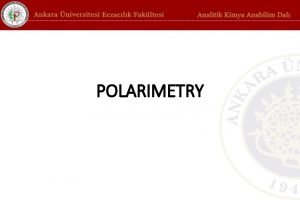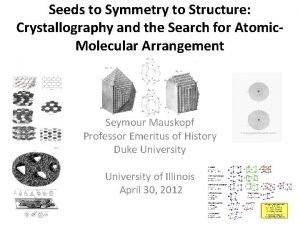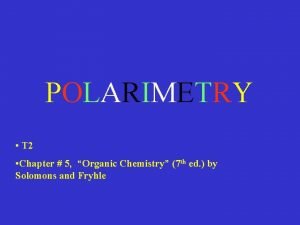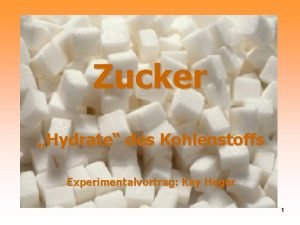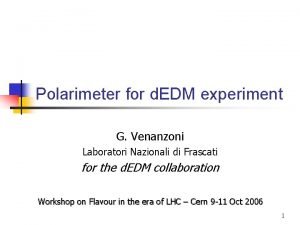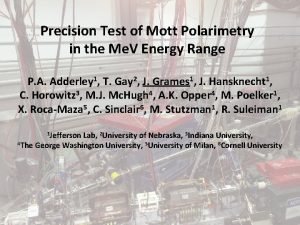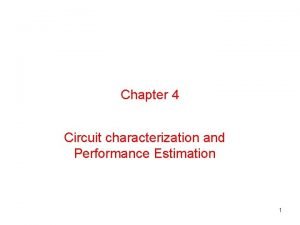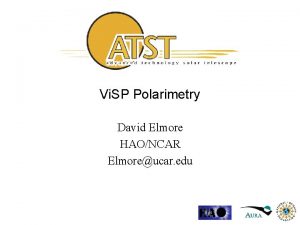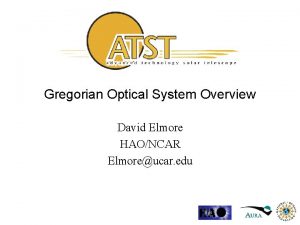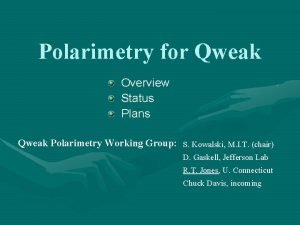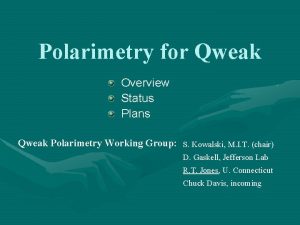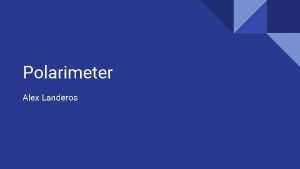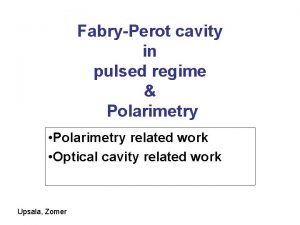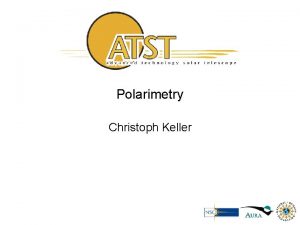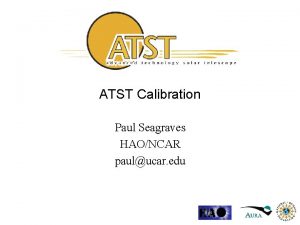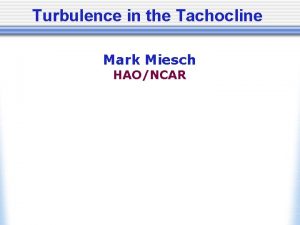Polarimetry Overview David Elmore HAONCAR Elmoreucar edu Polarimeter













- Slides: 13

Polarimetry Overview David Elmore HAO/NCAR Elmore@ucar. edu

Polarimeter Guidelines • Time multiplexed polarization modulation and analysis – Issues are understood – Versatile • Calibration optics precede highly polarizing reflections (Calibration station at Gregory focus) • Polarization modulators precede highly polarizing reflections (Modulator turret at Gregory focus) • Seeing induced errors reduced at high modulation frequency (k. Hz) • Seeing induced errors reduced using dual beam analyzer May 27 -28, 2004 Polarimetry Overview 2

Polarimeter Concept (HPP) • High Precision Polarimeter – Modulator at Gregory: • High speed Piezo-elastic (PEM) • Ferroelectric liquid crystal (Fe. LC) – Analyzer: Linear polarizer at Gregory – Advantages • k. Hz modulation frequency rejects residual seeing • No highly polarizing optics between modulator and analyzer – Disadvantages • Narrow wavelength range, but tunable • Charge caching photo-detector required May 27 -28, 2004 Polarimetry Overview 3

Polarimeter Concept (FAP) • Fast Achromatic Polarimeter – Modulator: Rapidly rotating achromatic retarder at Gregory (but not as fast as Fe. LC or PEM) – Analyzer at detector: Linear polarizer for 8 -state modulation or high frequency Fe. LC + linear polarizer for 4 -state modulation – Advantages • Hundreds of Hz modulation frequency helps reject residual seeing • Wavelength diversity possible – Disadvantages • • Highly polarizing optics between modulator and analyzer Time varying polarimeter response matrix Calibration intensive data collection and reduction Charge caching photo-detector required May 27 -28, 2004 Polarimetry Overview 4

Polarimeter Concept (SAP) • Slow Achromatic Polarimeter – Modulator: Achromatic slowly rotating retarder at Gregory – Analyzer: Polarizing beam splitter at detectors – Advantages • Wavelength diversity possible • Conventional CCD or IR detectors can be mixed with charge caching photo-detectors (that use rapidly chopped Fe. LC before analyzer) – Disadvantages • • Highly polarizing optics between modulator and analyzer Time varying polarimeter response matrix Calibration intensive data collection and reduction Charge caching detector needed for mixed scheme May 27 -28, 2004 Polarimetry Overview 5

Polarimeter Performance Specification Priority HPP FAP SAP Wavelength range 380 nm – 900 nm 1 Yes Yes Wavelength range 295 nm – 1090 nm 1 Yes Yes Wavelength Diversity 3 widely separated lines 2 No+ Yes Polarimetric accuracy* 5 x 10 -4 Icontinuum 1 Yes No Polarimetric sensitivity* 10 -5 Icontinuum 1 Yes No No Simultaneous operation with NIRSP 2 No+ Yes +Depends upon modulator type and particular lines *Additional study required May 27 -28, 2004 Polarimetry Overview 6

Further Analysis Fast Retarder • Fast modulation using a retarder – Up to 1600 Hz frame rate > 200 Hz to 400 Hz polarization modulation – 8 state demodulation – 4 state demodulation using Fe. LC at the analyzer May 27 -28, 2004 Polarimetry Overview 7

Further Analysis Fast Retarder May 27 -28, 2004 Polarimetry Overview 8

Further Analysis: Slow Retarder Fast Analyzer • Slow modulation using a retarder – Typically 50 Hz frame rate > 12. 5 Hz – 25 Hz polarization modulation – 8 state demodulation – Rapidly chopped analysis using Fe. LC at the analyzer May 27 -28, 2004 Polarimetry Overview 9

Further Analysis: Slow Retarder Fast Analzer May 27 -28, 2004 Polarimetry Overview 10

Phil’s Analysis May 27 -28, 2004 Polarimetry Overview 11

Bottom Line requirement May 27 -28, 2004 Polarimetry Overview 12

Further Analysis: Conclusions • Slow modulation using a retarder (50 hz frame rate) – Does not meet accuracy requirement – Superimposition of rapidly chopped analyzer does not help • Fast modulation using a retarder – Meets accuracy requirement for dual beam but not single – 4 state chopped analyzer helps V, but not Q. Good for reducing number of modulation states • How does Fe. LC or PEM perform? May 27 -28, 2004 Polarimetry Overview 13
